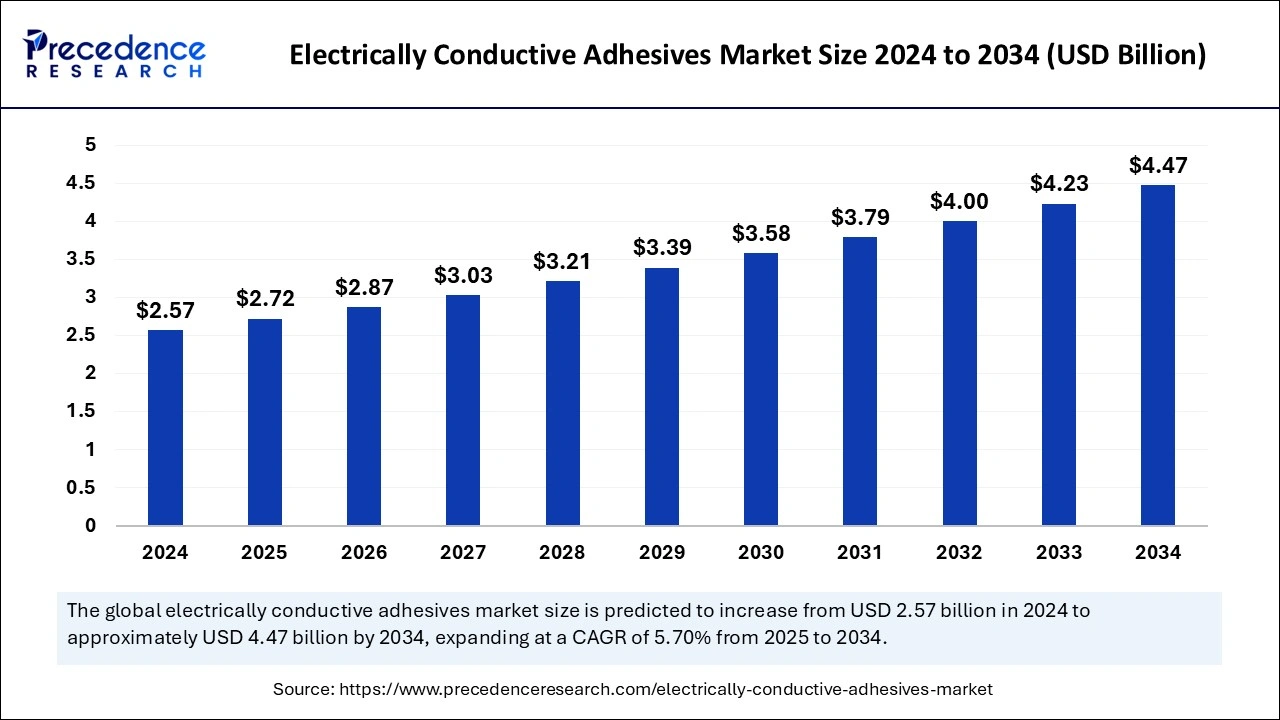The electrically conductive adhesives market is expected to reach USD 4.47 billion by 2034, up from USD 2.57 billion in 2024, with a CAGR of 5.70%.

Electrically Conductive Adhesives Market Key Takeaways
-
In 2024, Asia Pacific emerged as the leading region in the electrically conductive adhesives market, holding a 34% share.
-
North America is forecasted to register significant growth in the market during the coming years.
-
The isotropic conductive adhesives segment captured a major market share by type in 2024.
-
The anisotropic conductive adhesives segment is expected to expand at the fastest rate over the forecast period.
-
Among chemistries, the epoxy segment accounted for the largest share of 34% in 2024.
-
The silicone segment is poised to experience the highest growth throughout the projected period.
-
The silver filler segment generated a considerable portion of the market share in 2024.
-
By application, the automotive segment dominated the market in 2024.
Market Overview
The electrically conductive adhesives market is gaining momentum as industries seek lead-free alternatives to traditional soldering methods. These adhesives provide strong electrical conductivity while offering benefits such as flexibility, low-temperature curing, and compatibility with sensitive electronic components. Widely used in PCBs, touch screens, sensors, and automotive electronics, conductive adhesives play a crucial role in ensuring reliable electrical connections. As environmental regulations continue to push for the reduction of hazardous substances in electronic manufacturing, demand for conductive adhesives is expected to rise.
Drivers
The increasing shift toward environmentally friendly materials in electronics manufacturing is a primary driver for market growth. The expanding automotive industry, particularly the rise of electric vehicles and advanced driver assistance systems (ADAS), is fueling demand for conductive adhesives in battery management and sensor applications.
Additionally, the growing adoption of wearable technology and smart medical devices is driving the need for flexible and biocompatible conductive adhesives. Advancements in nanotechnology have also improved adhesive formulations, enhancing conductivity and mechanical strength.
Opportunities
The renewable energy sector presents significant opportunities for electrically conductive adhesives, particularly in solar panel manufacturing, where they are used for cell interconnections and module assembly. The rapid adoption of IoT devices in smart homes and industrial automation is creating new demand for high-performance conductive adhesives.
The development of conductive adhesives with improved heat dissipation and durability is expected to expand their applications in harsh environments, such as aerospace and defense electronics. Furthermore, collaborations between adhesive manufacturers and electronics companies are fostering innovation and enabling the commercialization of next-generation products.
Challenges
Despite the advantages of conductive adhesives, their higher cost compared to traditional soldering materials remains a challenge for widespread adoption. Adhesion strength and conductivity performance vary based on formulation and application conditions, requiring precise process control to ensure consistent results. Additionally, the complexity of integrating conductive adhesives into existing manufacturing processes can hinder adoption in certain industries.
Regional Insights
Asia-Pacific remains the largest market for electrically conductive adhesives, driven by the region’s dominance in electronics manufacturing. China and Taiwan lead in semiconductor production, while South Korea and Japan are key players in advanced display and automotive electronics.
North America and Europe are seeing increasing demand, particularly in medical electronics and aerospace applications. Emerging economies in Latin America and the Middle East are also experiencing growth due to rising investments in electronic component manufacturing.
Recent Developments
Companies are focusing on developing silver-free conductive adhesives to reduce costs and ensure sustainable supply chains. The introduction of hybrid adhesives combining conductive and thermal management properties is gaining traction in the market. Industry leaders are investing in AI-driven quality control systems to enhance the precision of adhesive application in automated assembly lines.
Electrically Conductive Adhesives Market Companies
- Henkel AG & Co. KGaA
- Dow Corning Corporation
- 3M Company
- Aremco Products, Inc.
- Parker Hannifin Corporation
- Panacol-Elosol GmbH
- Masterbond Inc.
- H.B. Fuller Company
- MG Chemicals Ltd.
- Creative Materials Inc.
- Permabond Engineering Adhesives Ltd.
- Polytec PT GmbH
Segments Covered in the Report
By Type
- Isotropic Conductive Adhesives
- Anisotropic Conductive Adhesives
By Chemistry
- Epoxy
- Polyurethane
- Silicone
- Acrylic
- Others
By Filler Material
- Silver Fillers
- Copper Fillers
- Carbon Fillers
- Others
By Application
- Automotive
- Biosciences
- Consumer Electronics
- Aerospace
- Others
By Geography
- North America
- Europe
- Asia Pacific
- Latin America
- Middle East and Africa
